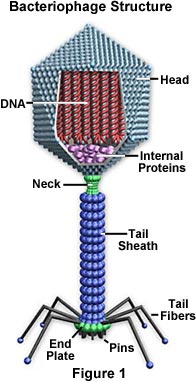VIRUSES.
An obligate intracellular parasite.
This means that they are ONLY able to reproduce WITHIN a cell.
Outside the cell they are without activity and cannot perform any of the life functions on there own. They are not cells or even called living organisms.
A virus contains a nucleic acid genome inside a protein shell. Once the virus enters the cell it uses its genome to replicate its genome and protein, although the nature of each may vary between different viruses.
A viral genome may consist of DNA or RNA. It can be single or double stranded or linear or circular. Viruses utilize every type of nucleic acid as its genome but a given virus can only have one type of nucleic acid as its genome.
SIZE is a limiting factor for viruses. They are smaller than the host that they infect. The exterior protein of a virus is typically a rigid structure that wont expand to fit any larger genome. Even though there size is limited you would wonder how they are able to pack all the material needed to carry out reproduction, viruses rely on host-encoded proteins for translation, transcription and replication.
Viruses have the ABILITY to encode more than one protein in a certain length of genome. The can this by having more than one reading frame within a piece of DNA.
Most animal viruses have an ENVELOPE. This EXTERIOR membrane is derived from the INTERIOR membrane of the host cell. This envelope is acquired through budding of the host cell. Viruses that do not have an envelope are called naked viruses. Phages and plant cells are of this type of virus.
BACTERIOPHAGE LIFE CYCLE (VIRUSES THAT INFECT BACTERIA)

1. ATTACHMENT -binding to the exterior bacteria
2. PENETRATION -genome released into the cell while the protein coat stay outside the cell
3. The virus can now enter LYTIC OR LYSOGENIC CYCLE

